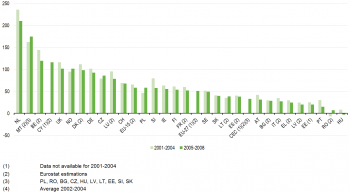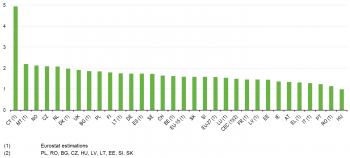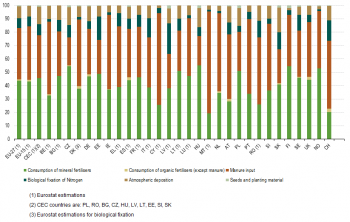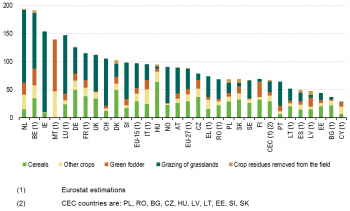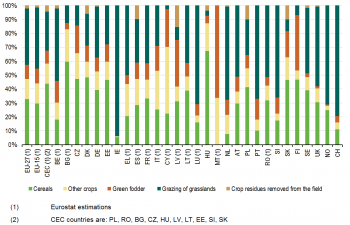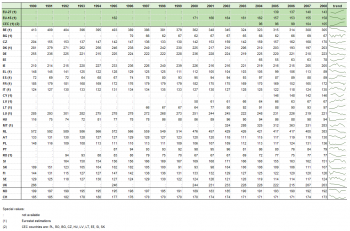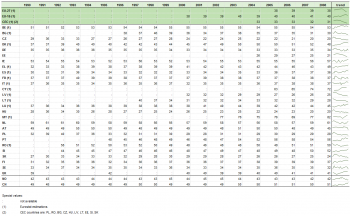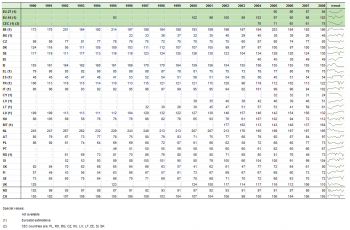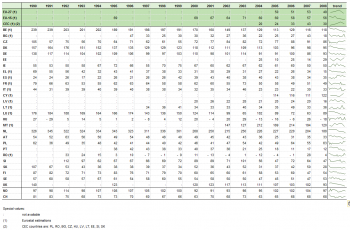Archive:Agri-environmental indicator - gross nitrogen balance
Data from March 2012. Most recent data: Further Eurostat information, Main tables and Database.
This background article contains a fact sheet of the agri-environmental indicator (AEI) gross nitrogen balances. Together with other fact sheets, it provides an overview of the state of the agri-environmental indicators in the European Union (EU).
Indicator definition
Potential surplus of nitrogen on agricultural land (kg N/ha/year).
Measurements
Main indicator:
Potential surplus of nitrogen on agricultural land (kg N/ha/year).
Links with other indicators
- AEI 5 - Mineral fertilizer consumption
- AEI 10.1 - Cropping patterns
- AEI 10.2 - Livestock patterns
- AEI 18 - Ammonia emissions
- AEI 19 - Greenhouse gas emissions
And influences:
- AEI 27.1 - Water quality – Nitrate pollution
Main findings
Key messages
- In most countries the average Gross Nitrogen Surplus (GNS) per ha between 2005 and 2008 was lower than between 2001 and 2004 (Figure 1). Exceptions were CZ, LT, MT, PL, RO and NO. Data for CY and EE were not available for 2001-2004.
- The average GNS 2005-2008 is higher in EU-15 (58 kg N per ha) than in the Central and East European Countries (CEC)[1] (33 kg N per ha).
Main warnings
- Climatic conditions have a big impact on the balance through the impact on yield and therefore N output. Climate and weather conditions are beyond the control of the farmer. To dampen the effect of weather conditions results on the nutrient balance are presented as an average for a certain period.
- All references to area in this fact sheet based on data from the nutrient balances relate to the reference area. At the moment the reference area is based on the land-use statistics in Eurostat, and consists of arable land, land under permanent crop and permanent grassland. Note that this area is not equal to the UAA, as the UAA also includes area under glass and kitchen gardens. Some countries have excluded certain extensive areas from the reference area as well.
- Due to methodological issues or missing data balances have been estimated by Eurostat for: MT, BE, DK, CY, IT, ES, LU, FR, LT, LV, BG, RO, EL. The results of these countries can only be regarded as a rough indication of the GNS.
- The quality and accuracy of the estimated GNS per ha is depending on the quality and accuracy of underlying data and coefficients used. As methodologies (especially with regards to the coefficients) and data sources used in countries vary substantially the balances are only consistent within a country across time. The Gross Nitrogen Balances are not consistent across countries, which means that data cannot be compared between countries.
- There are several actions ongoing to improve the methodology and data of the Gross Nitrogen Balances, such as a revision of the Handbook by the end of 2012, tender on excretion coefficients and grasslands in 2012 and grants in 2012 to improve crop coefficients.
Context
Introduction
The Gross Nitrogen Balance (GNB-N) lists nitrogen inputs to agricultural soils and nitrogen outputs removed from the so
il. The main result from the GNB-N is the Gross Nitrogen Surplus (GNS) which is calculated as the difference between total N inputs and total N outputs. The GNS can also be expressed in kg N per ha, by dividing the surplus by the reference area. The GNB-N provides insight into links between agricultural nitrogen use and losses of nitrogen to the environment. A persistent surplus indicates potential environmental problems, such as ammonia emissions (contributes to acidification, eutrophication and atmospheric particulate pollution), nitrate leaching (resulting in pollution of drinking water and eutrophication of surface waters) or nitrous oxide emissions (a potent greenhouse gas). A persistent deficit indicates the risk of decline in soil fertility.
The GNB-N can only indicate the potential risk to the environment as the actual risk depends on many factors including climate conditions, soil type and soil characteristics, management practices such as drainage, tillage, irrigation etc.
Policy relevance and context
- Rural Development Programme (RDP): The Agri-Environmental Measure was introduced in 1992 under the Mac Sharry reform of the CAP, integrated as an obligatory measure within the Rural Development Regulation in 1999 (pillar two) in order to promote environmental friendly farm practices. The key objectives of these measures are to promote agricultural methods to protect the environment and maintain the countryside. The Member States develop their own agri-environment measures according to their environmental needs. Some measures are designed inter alia to reduce the use of inputs, to conserve valuable farmed habitats, and to introduce changes in land use for environmental purposes. These identified positive impacts contribute to biodiversity, landscape, water and soil resources. Nitrogen balances are required for the Rural Development Programme 2007-2013 (Regulation 2005/1698) as part of the EU’s Common Monitoring and Evaluation Framework to assess the impact of RDP. The CMEF is laid down in a set of documents drawn up by the Commission and agreed with the Member States. These documents are put together in a Handbook, which includes a series of evaluation guidelines and guidance sheets on the common indicators.
- The Water Framework Directive 0060/2000 (WFD) requires Member States to protect and restore the quality of their waters. Water management is based on natural geographical and hydrological formations: the river basins. It sets out a precise timetable for action, with 2015 as the target date for getting all EU waters into good status. A good status is defined through several factors: biology, chemistry as well as morphology and quantity. Environmental quality standards are defined as the concentration of a particular pollutant or group of pollutants, sediment or biota, which should not be exceeded in order to protect the environment. In the legislative text of the Water Framework Directive, there is an indicative list of pollutants that contribute to eutrophication (in particular nitrates and phosphates). Measures applied under the Water Framework Directive affecting the use of nitrogen in agriculture relate to best environmental practices. They may include the reduction of nutrient application, the modification of cultivation techniques and the proper handling of fertilisers. Most measures suggested in this context are aimed at reducing the influx of nutrients, such as nitrogen and phosphorus to the groundwater as well as surface waters. The N balance surplus (every 6 years at level of water body catchment) is a commonly used indicator for identifying areas vulnerable to nutrient pollution in the WFD pressures and impacts analysis.
- The Nitrates Directive 0676/1991 (ND), aims to reduce water pollution caused or induced by nitrates from agricultural sources and prevent further such pollution. The directive requires the Member States to monitor nitrate concentrations in surface water and groundwater, identify waters affected by pollution and waters which could be affected by pollution if no measures are taken and designate vulnerable zones, defined as all known areas of land which drain into the waters identified. For these vulnerable zones, action programmes containing measures to reduce and prevent nitrate pollution must be developed, implemented and revised every four years. The action programmes of MS should contain rules relating to the limitation of the land application of fertilizers based on a balance between the foreseeable nitrogen requirements of the crops, and the nitrogen supply to the crops from the soil and fertilization. These balances should be calculated at farm level every 4 years.
- The 6th Environmental action Programme encourages the full implementation of both the ND and WFD, in order to achieve levels of water quality that do not give rise to unacceptable impacts on, and risks to, human health and the environment.
Other policies which are indirectly linked to the Gross Nitrogen Balance are:
- National Emissions Ceiling Directive 0081/2001 sets upper limits for each Member State for the total emissions in 2010 of the four pollutants responsible for acidification, eutrophication and ground-level ozone pollution (sulphur dioxide, nitrogen oxides, volatile organic compounds and ammonia), but leaves it largely to the Member States to decide which measures – on top of Community legislation for specific source categories - to take in order to comply. The implementation of the directive requires that Member States develop national programmes in 2002 and, where needed, revise those plans in 2006 that aim at meeting fixed ceilings of national emissions by 2010 and thereafter. Further, Member States have to report their emission inventories to the EEA and the European Commission in order to monitor progress and verify compliance.
- The Directive on Integrated Pollution Prevention and Control Directive 0001/2008 introduces an integrated cross-media approach, aiming to prevent or minimise emissions to air, water and land, as well as to avoid waste production with a view to achieve a high level of environmental protection as a whole. The purpose of the IPPC Directive is to achieve integrated prevention and control of pollution arising from several categories of industrial activities. Among these are installations for the intensive rearing of poultry or pigs with more than 40 000 places for poultry, 2 000 places for production pigs (over 30 kg), or 750 places for sows. The indicative list of main polluting substances to be taken into account if they are relevant for fixing emission limit values includes oxides of nitrogen and substances which contribute to eutrophication (phosphates and nitrogen)The Commission has adopted a new Proposal for a Directive on industrial emissions (integrated pollution prevention and control) in 2007.
- Habitats Directive 0043/1992 and Birds Directive 0147/2009: The main purpose of these Directives is to ensure biological diversity through the conservation of natural habitats and of wild flora and fauna within the European territory, while taking into account economic, social, cultural and regional requirements. Farmers who have agricultural land in Natura 2000 sites and face restrictions due to the requirements of the Habitats and Birds Directives are eligible to receive rural development payments for the management of these sites. Depending on the specific conditions of a certain area, Natura 2000 management plans may include measures to reduce the use of pesticides and fertilisers, measures to mitigate the effects of soil compaction, e.g. limitations on the use of machinery or the setting of stocking limits, or measures aiming to regulate the irrigation of agricultural land.
- United Nations Framework Convention on Climate Change (UNFCCC): The Kyoto Protocol is an international agreement linked to the United Nations Framework Convention on Climate Change. The major feature of the Kyoto Protocol is that it sets binding targets for 37 industrialized countries and the European community for reducing greenhouse gas (GHG) emissions. These amount to an average of five per cent against 1990 levels over the five-year period 2008-2012. The major distinction between the Protocol and the Convention is that while the Convention encouraged industrialised countries to stabilize GHG emissions (CO2, CH4, N2O, PFCs, HFCs, SO2, NOx, CO and NMVOC), the Protocol commits them to do so. Reporting is done by the countries through the submission of annual emission inventories and national reports under the Protocol at regular intervals. Items to be reported under the protocol include Mineral Nitrogen fertilisers' application by agriculture, livestock excretion, emission factors etc.
- United Nations Economic Commission for Europe Convention on Long Range Transboundary Air Pollution: Parallel to the development of the EU NEC Directive, the EU Member States together with Central and Eastern European countries, the United States and Canada have negotiated the "multi-pollutant" protocol under the so-called Gothenburg protocol, agreed in November 1999. The emission ceilings in the protocol are equal or less ambitious than those in the NEC Directive.
Agri-environmental context
The Gross Nitrogen Balance indicates the total potential risk to the environment (air, water and soil). The output side of the balance presents the nutrient uptake by harvested (and grazed) crops and fodder and crop residues removed from the field; i.e. the agricultural production from the soil. The input side of the balance counts all N supplied to the soil. Sustainability could be defined by preserving and/or improving the level of production without degrading the natural resources. The harvest and grazing of crops and fodder means that N is removed from the soil. To sustain soil fertility this removal of N in principal should be compensated by supplying the same amount of N. Fertilisers and manure are therefore necessary to supply the crops with the necessary N for growing. There are certain complications however; not all of N in fertilisers and manure reaches the crop, a part of the N in fertilisers and manure is lost due to volatilisation in animal housing, storage and with the application to the land, organic N in manure first needs to be mineralized before it is available to the crop which means that part of the N may need different time-lag for being available to plant (depending on soil characteristics and climate conditions –temperature and precipitations).. Yield and therefore the uptake of N by crops is not only determined by inputs but also by uncontrollable factors like weather. Furthermore, the risk of N leaching and run-off does not only depend on the excess N but also on the type of soil, precipitation rates, soil saturation, temperature etc. Abating measures to reduce N emissions directly impact the amount of N in manure and fertilisers applied to the soil. A higher emission rate means lower N content of manure/fertilisers applied to the soil, but means a higher contribution to environmental problems related to GHG and NH3 emissions. Lowering the emission rate means increasing the rate of N in manure/fertilisers, and therefore increasing the potential risk of leaching and run-off.
The estimated N surplus on its own therefore does not tell so much on the actual risks to the air, water and soil. The actual risk depends on many factors including climate conditions, soil type and soil characteristics, soil saturation, management practices such as drainage, tillage, irrigation etc. The actual risks to the environment are better represented by the indicators 18 Ammonia emissions, 19 GHG emissions, 27.1 Water quality (Nitrate pollution). These indicators however do not present a link between the agricultural activities and the environmental impact. The Nitrogen Balance presents a link between agricultural activities and the environmental impact; it identifies the factors which determine the N surplus and shows the change over time.
Assessment
Analysis at EU level
Data for EU-27 could only be compiled for 2005-2008. The Gross Nitrogen Surplus for EU-27 remained relative stable between 2005 and 2008 with an estimated average of 51 kg N per ha. Data for EU1-5 could be compiled for 2001-2008, showing that the Nitrogen balance for the EU-15 reduced between 2001 and 2008 from an estimated average of 66 kg N per ha in the period 2001-2004 to 58 kg N in the period 2005-2008. The Gross Nitrogen Surplus of the CEC countries is much lower than that of EU-15 with an estimated average of 33 kg N per ha in 2005-2008. The average GNS per ha is highest on average between 2005 and 2008 in countries in the North-West of Europe (BE, NL, NO, UK, DE, DK) and the Mediterranean islands MT and CY, while many of the Mediterranean (PT, IT, ES, EL) and CEC countries belong to the countries with the lowest N surpluses (Figure 1).
Another way of presenting the result of the Gross Nitrogen Balance is the Input/Output ratio, which gives an indication of the nitrogen use efficiency. It should however be noted that in the present methodology, N which is volatilised during animal housing, manure storage and with the application of fertilizers and manure, is included in total N Input. This part of the N is however not available to the crop. To estimate the Nitrogen Use Efficiency, the Gross Nitrogen Surplus would need to be corrected for the N-gas emissions. Figure 2 shows that the ratio between Total Nitrogen Inputs and Total Nitrogen Outputs is relatively high for CY, MT, NO, CZ, NL and DK which also have a high nutrient surplus per ha.
Figure 3 shows that many of the countries with a high N surplus also have a relative high N input per ha (for instance NL, MT, BE), though a high input does not necessarily lead to a high N balance, as the balance also is determined by the output. The N input per ha of IE (estimated at 210 kg N per ha) for instance is comparable to that of the UK (estimated at 212 kg N per ha), but the N surplus of IE is 45% lower, as the N output per ha in IE was estimated on average 155 kg N per ha and the output in the UK only 111 kg N per ha as can be seen in Figure 6.
The inputs of the Gross Nitrogen Balance consists of inorganic fertilisers, other organic fertilisers (excluding manure), gross manure input, atmospheric deposition, biological fixation and seeds and planting material. Inorganic fertilisers and manure account for more than 80% of the N input in the EU27 between 2005 and 2008. The N input with seeds and planting materials is negligible. At the moment the re-use of N through the use of compost, sewage sludge, industrial waste etc is insignificant. Data on other organic fertilisers are lacking in many countries, therefore the significance of these fertilisers could be underestimated. Biological fixation is on average 7% of total N input in the EU-27. However, as at the moment due to methodological issues biological nitrogen fixation in grass/legume mixtures is not included in the estimations, the significance of biological fixation might be underestimated. The level of atmospheric deposition is depending on NH3 emissions (of which agriculture is the main source) and nitrogen oxides emissions (where the contribution of agriculture is not significant) and climate conditions (transport through air to other regions). Atmospheric deposition was on average 9% of total inputs in the EU-27.
Figure 4 shows large differences between countries in the use of inputs. The choice of fertilizer type (manure, mineral fertilizers, other organic fertilizers) has different impacts on the environment:
- Nitrogen volatilizes from manure in animal housing, storage and with the application to the land. These emissions mainly depend on the type of manure, farm management practices like type of animal housing, manure storage, timing and application techniques.
- N emissions from mineral fertilizers during the application to the land depend on type of fertilizer, farm management practices like application techniques, timing and other factors such as soil type, and weather conditions.
- The N is not available to the plant in the same rate for different types of manure and mineral fertilizers.
- Other potential fertilisers like urban wastes often include health hazards (to both crops and humans) and procedures commonly used to reduce these hazards - such as composting - tend to reduce the fertilizer value (leaching/volatilisation).
- Nitrogenous fertilisers are produced using gas, the production of N fertilisers contributes therefore to GHG emissions and fossil fuel depletion.
Mineral fertiliser consumption is the main input in EU-27 in 2005-2008 with an average of 44% in total Nitrogen inputs, followed by the gross manure input (38%). The share of manure in total inputs is on average for 2005-2008 smaller in the former CEC countries (32%) than in the EU-15 Member States (40%). Manure withdrawals (manure processing, non-agricultural use, export and stock changes) and imports are only of significance (>5% of total manure production) in a very few countries (BE, NL, HU). This means that for most countries the manure used is mainly determined by the amount of manure produced in the country. The manure production in kg N per ha was almost twice as high on average in the EU-15 as in CEC countries in the period 2005-2008. The manure production is determined by the amount and type of livestock in the country. Figure 3 in the fact sheet livestock patterns shows the livestock density in EU-27 in 2007. MT, NL, BE, DK, CY and IE have the highest livestock densities and also have the highest rates of manure input per ha (>=100 kg N per ha). RO, BG, LT, SK, EE and LV have the lowest livestock densities and also belong to the countries with the lowest rates of manure input per ha (<40 kg N per ha). The countries with the highest livestock densities also belong to the countries with a high share (>=50%) of manure in total input. PT and RO, two countries with a relative low livestock density have a relative high share of manure in total input as well, due to a low use of mineral fertilizers. Figure 3 in this fact sheet shows that some of the countries (NL, BE) with the highest use of manure per ha also have a high use of mineral fertilizers (>100 kg N per ha), while some of the countries (RO, ES, LT, SK, BG, LV, EE) with the lowest rates of manure per ha (<40 kg N per ha) also belong to the countries with a relative low use (<50 kg N per ha) of mineral fertilizers per ha.
Figure 5 shows that cattle is the main source of manure production and more than 50% in all countries, except in DK where pigs have the highest share, in MT, ES, HU, BG, RO where different livestock types are important and in CY and GR where sheep and goats have the highest share.
The removal of Nitrogen with harvest and grazing of crops and forage per ha varies between crops and countries as can be seen in Figure 6. Per ha, grassland and cereals production have the highest N removal rates, though great variation exists between countries due to differences in yields and N content per tonne of product. The N content per tonne product is among others depending on farmer practices like fertilisation, irrigation, mowing vs grazing etc. It should however be noted that coefficients may also vary among countries and crops due to differences in methodologies used, see also section on data and methodology.
The dominant share of total N output in the EU-27 (2005-2008) is the uptake of N with cereal production (ca 1/3) and grassland (40%), see Figure 7. N output is depending on cropping patterns, yields, farm management practices (tillage, irrigation etc), climate etc. Figure 2 in fact sheet 10.1 cropping patterns shows the cropping pattern in 2007, when permanent and temporary grassland covered 39% of the UAA in EU-27 (38% in 2005) and cereals 34% (same as 2005). There are however significant differences between countries, in some countries (for example UK, SI, IE, NO) grassland dominates the UAA, whereas for instance in BG, HU and DK cereals are the dominating crop. Permanent crops are significant in Mediterranean countries.
Analysis at country level
As explained in the section on data and methodology, the current balances are not comparable between countries due to differences in definitions, methodologies and data sources used by countries. In the next section a few trends and specifics at Member States level are highlighted.
Since 1990 Nitrogen inputs per ha have been continuously decreasing for BE, DK, EL, LU, NL, and UK. In CEC countries the total N input decreased significantly during the economic transition (e.g. in CZ and PL total N Input decreased with ca 1/3 between 1989 and 1993). In some of the CEC countries a trend towards recovery can be noted, for example CZ and PL, while in other countries such a trend cannot be noted and N inputs remain well below the level before the transition, e.g. SK (Table 1).
The main nitrogen input at EU-27 level are mineral fertilisers, see Figure 4. In DE, ES, FR, LU, HU, FI, SE and UK the share of mineral fertilisers was larger than the share of manure in total nitrogen inputs between 1990 and 2008. In various CEC countries (e.g. BG, CZ, HU) the share of mineral fertilisers in total nitrogen inputs increases from 1996-2008, as consumption of mineral fertilisers increased and manure inputs decreased. In many CEC countries manure N input decreased significantly following sharp declines in livestock populations during and directly after the transition, In CZ, for example, two-third of the manure production (tonnes of nitrogen) is produced by cattle and a fifth by pigs (average 2005-2008, Figure 5). Pig and cattle populations decreased between 1990-2010 with ca 60% in CZ[2], which had a significant impact on the manure production and manure input[3]. Manure input (tonnes of nitrogen) decreased with 42% between 1990-2008 in CZ. In AT, BE, IE, NL, RO, SI, PT and CH the share of manure input is larger than the share of mineral fertilisers between 1990 and 2008. In DK the share of manure in total inputs was initially lower than that of mineral fertilisers. Mineral fertiliser consumption in DK however decreased significantly (-43%) between 1990 and 2008. As manure input decreased only slightly (-5%) in the same period, the share of manure in total inputs increased gradually to surpass the share of inorganic fertilisers in total inputs in 1999 (Tables 2 and 3).
Manure input in the Gross Nitrogen Balance is based on manure production, manure withdrawals and manure import where the manure production is calculated from livestock numbers and excretion factors. The average N excretion per animal per year is depending on animal characteristics (e.g. production level, race etc) and farmer practices (for instance animal diets). Many countries take the average level of milk production per cow into account in the estimation of excretion coefficients (a higher level of milk production per cow in general means a higher feed intake and therefore a higher N excretion). Excretion coefficients are at the moment only updated regularly to take into account changing farmer practices in a few countries. Most countries use fixed coefficients, this means that for these countries changes in farmer practices other than reducing animal numbers are not taken into account. DK is one of the countries which has updated its excretion coefficients regularly. The excretion coefficients of cattle for example show an increasing trend after 2000 and a decreasing trend for pigs between 1985 and 2003. The effect of the change in excretion coefficients is significant: Total manure N production by pigs in DK increased only with 6% between 1990 and 2008 though total pig population increased during the same period by 34%, this effect is completely due to the development in the excretion coefficients. Another country which regularly updates excretion coefficients is the NL. The excretion coefficients in the NL are estimated annually based on a model which takes into account animal feed requirements, statistical data on livestock numbers, animal products, feed production, grazing systems, animal housing etc and other data. The N excreted per animal per year decreased for most livestock types (though for certain livestock types the average N excretion per animal per year increased, for example fattening calves and goats for dairy).
The estimated Nitrogen output depends mainly on the yields of crops and fodder as in most countries the coefficients used to determine the nutrient contents of crops are constant over time. In NL, data on nutrient contents of grassland products and silage maize are updated annually and are based on a large sample of measurements from dairy farms. These data show a significant downward trend in the nutrient content of grassland products since 1996 and silage maize between 1990-2000 a.o. due to a significant decrease in fertilisers used on these crops[4]. The yields of crops and fodder are influenced by farmer practices (like pesticide and fertiliser use, irrigation etc) and by soil type and weather. Weather conditions vary significantly from year to year and these fluctuations can also be seen in the estimated nitrogen outputs and surplus. In 2003 and 2007 large parts of Europe were hit by extreme weather conditions[5] causing significant drops in crop production. In many Member States a peak in the balance can be noted for these years. Variations in the Nitrogen Surplus between years should therefore be interpreted with care. Table 4 shows the nitrogen outputs per ha and Table 5 the nitrogen surplus per habfor EU-27, NO and CH between 1990 and 2008. For some countries the trend in output is equal to the trend in input, for example a decreasing trend in N inputs over time is followed by an decreasing trend in Nitrogen outputs in the NL and DK, for other countries the trend in output does not follow the trend in inputs, for example the output remained more or less constant with decreasing inputs in BE and even increased in LU.
Data used and methodology
The methodology of the nitrogen balances is described in Eurostat/OECD Gross Nitrogen Balance Handbook. The Gross Nitrogen Balance lists all inputs and outputs and calculates the Gross Nitrogen Surplus as the difference between total inputs and total outputs. The Gross Nitrogen Surplus per ha is derived by dividing the total Gross Nitrogen Surplus by the reference area. The reference area of the current version of balances uploaded in Eurobase is the sum of Arable Land (L0001), Permanent Grassland (L0002) and Land under Permanent Crops (Data on these areas can be found in Eurobase (apro_cpp_luse))
The inputs of the Nitrogen Balance are:
- Fertilisers:
- Inorganic Fertilisers.
- Organic Fertilisers other than manure.
- Gross Manure Input:
- Manure production (represents the N at the time of excretion, id est no reductions are made for N
losses due to volatilisation in stables, storages and with the application to the land).
- Manure withdrawals. Manure export, Manure processed as industrial waste, Non-agricultural use of
manure, other withdrawals.
- Change in Manure Stocks.
- Manure import.- Other Nitrogen Inputs:
- Seeds and Planting Material.
- Biological Fixation by Leguminous crops and free living organisms.
- Atmospheric deposition.
The Outputs of the Gross Nitrogen Balance are:
- Total removal of Nitrogen with the harvest of crops (Cereals, dried Pulses, Root crops, Industrial crops, Vegetables, Fruit, Ornamental plants, Other harvested crops).
- Total removal of Nitrogen with the harvest and grazing of Fodder (Fodder from arable land, Permanent and Temporary Pasture consumption).
- Crop residues removed from the field.
The N input and N output is estimated for each item of the balance from basic data by multiplying with coefficients to convert the data into N content. Basic data are mostly derived from agricultural statistics. Coefficients are mainly estimated by research institutes and can be based on models, statistical data, measured data as well as expert judgements. A more detailed description of the data used and coefficients follows in the next paragraph.
Quality and availability of data
The balance is estimated from several inputs and outputs. The in- and outputs are estimated from basic data multiplied by coefficients to convert the data in nutrient contents. The most significant basic in- and output data are fertiliser consumption, crop production, livestock number, agricultural area.
Data on fertiliser consumption is available in many countries from country specific data sources (surveys, trade/production statistics), for countries where such data was not available data from Fertilizers Europe have been used. Data on fertiliser use for MT was only available from the FAO. Due to different data sources used (farmer surveys vs trade/production statistics) and inherent problems of data sources used (for instance inclusion of non-agricultural use in statistics based on trade and production) the quality of data cannot be sufficiently verified. There is need for a common methodology to estimate fertiliser consumption by agriculture to ensure reliable and consistent estimations and comparability across MS.
Data on crop production, livestock number, and agricultural area are available in all countries from harmonised and regulated European statistics (FSS, animal production statistics, livestock registers, crop production statistics). Livestock numbers have been checked with statistics in Eurostat. These data can be considered to be of good reliability.
Excretion coefficients delivered by the country have been used together with the livestock numbers reported by the country to estimate manure production. The excretion coefficients represent the amount of N in manure at the time of excretion, id est no reductions have been made for volatilisation from the moment of excretion till the application to the land. In the case country did not deliver excretion coefficients, the excretion has been estimated by animal numbers and excretion coefficients as reported in the 2010 country submissions of to UNFCCC GHG Inventory (http://unfccc.int/national_reports/annex_i_ghg_inventories/national_inventories_submissions/items/5270.php). Verification and validation of the coefficients requires expert knowledge. A European uniform methodology and validation procedure to estimate excretion coefficients would be necessary to ensure reliable and consistent estimations and comparability across MS. At present the estimation of coefficients vary between countries in methodology (expert judgement vs complex models based on statistical data) and in updating procedures (to take into account the effect of mitigation actions (other than reducing the level of production) in the estimations, coefficients need to be updated regularly to reflect these changes in farmer practices (mitigation actions)). Because excretion is a large part of the balance, the data (especially the level of surplus) cannot be compared between countries as these are largely depending on coefficients used which are based on varying methodologies.
Manure withdrawals, manure stocks and imports are not available in most countries but are likely not significant with the exception of a few countries (NL, BE, DK) who already submitted such data. HU reports that 20% of manure is not used in agriculture. This amount is however not verifiable, also the question is where this amount of manure has been placed remains. Not taking into account the non-agricultural use would increase the balance per ha for HU with ca 5 kg N/ha.
Crop production is available from reliable statistics for most of the significant crops cultivated except grassland. The harvest and grazing of grassland is estimated in some countries based on feed requirement models (for example the NL), while in other countries expert judgement is used. As grassland production is estimated on average as 40% of total N output in the EU27 (in 2005-2008) the estimation of grassland determines to a large extent the outcome of the balance. It is necessary to develop a uniform European method to estimate grassland production to ensure reliable and consistent estimations and comparability across MS. Only the N uptake by crops and fodder harvested and crop residuals removed from the field are included in the output of the balance. For permanent crops a part of the N uptake is stored in the plant (which is not harvested) and is therefore not at risk to run-off, leaching or volatilisation, this is not taken into account in the balance estimations. Many countries do not have coefficients (used to convert the production in nutrient content) available and reliability varies due to the method used (scientific research vs expert judgement). Verification and validation of these coefficients requires expert knowledge. A sufficient European structure to verify and validate these coefficients is missing. Improvements in the coefficients used are therefore necessary.
Seeds and planting material have been estimated when the required data were available. The quality of data depends on the data sources and assumptions made, as well as the availability and quality of coefficients. This item is however not of large significance to the final balance. It could be considered to drop this item from the balance, or invest in improvements of the estimation of the most significant seed inputs.
Biological fixation coefficients are limited available and determined using different methods across MS (scientific research vs expert judgement). Verification and validation of these coefficients requires expert knowledge. A sufficient structure to verify and validate these coefficients is missing. Estimation of the most important item grass/clover mixtures is currently not possible by most MS and has therefore not been included in the current balance estimations. Data received from DK on biological fixation by grass/clover mixtures show that this item would be on average 5% (in the period 2000-2008) of total inputs in DK. The biological fixation by free living organisms is in most countries based on an assumption and, as this item is not of major significance, it could potentially be dropped in the future from the balance. Improvements are needed in the estimation of biological fixation especially including the estimation of grass/legume mixtures.
Rates on the atmospheric deposition have been obtained from MS and, when countries did not have data available, from the European Monitoring and Evaluation Programme (EMEP) (http://webdab.emep.int/Unified_Model_Results/AN/). The deposition rates delivered by the MS have not been verified. In the future to ensure reliable and consistent estimations and comparability across MS, it is proposed to use data of EMEP for all MS.
At present the volatilisation is included in the manure production at the input side. This leads to a double counting of N at the input side when deposition is not corrected for domestic deposition of N from agriculture. The atmospheric deposition of N is due to ammonia and nitrogen oxides emissions. Reduced nitrogen deposition (ammonia emissions) is ca 60% of total N deposition in EU27 in 2008 (EMEP). The largest source of ammonia emissions is agriculture (EEA: ca 94% of total NH3 emissions in EU27 in 2008 are derived from agriculture). The contribution of agriculture to oxidized nitrogen deposition is negligible (EMEP). Emissions are however transported through the air, it is therefore difficult to provide estimations on the N deposited from domestic agriculture in a country. Deposition of nitrogen is of significance in most countries and varies from 2-19% of total N input. The double counting (on average for the EU27 could be assumed to be half of the estimated deposition) can therefore lead to some overestimation of the N balance. To avoid double counting, the deposition rate of Nitrogen should be corrected for N-deposits from domestic agriculture. At present only the NL has corrected deposition, double counting is therefore present in all of the balances except the NL. It is proposed to estimate the volatilisation of N from manure (NH3, N20, NOx etc in animal housing, during storage and with the application to the land) and from mineral fertilisers (NH3 emissions with application to the land). The balance could then as well be estimated excluding emissions, which would give an indication of the aquatic risk and solve the problem of double counting in deposition. The emissions could also be explicitly presented in the balance, providing more information.
Reference area: The balance should in principle relate to the potential fertilised area, excluding very extensive unfertilised areas, to make comparisons useful and to identify the potential risks of agricultural production to the environment in respect to N surplus and deficits. To illustrate the necessity of identifying the correct reference area to make useful comparisons between regions in Europe: As an example suppose a country has 200.000 ha of very extensive area where 5% of production takes place and 200.000 ha of high intensive livestock and crop production. Though the N surplus of the high intensive area which produces 95% of total production could be high (for instance 100 kg N per ha), this would not show up in the balance for the whole country as including the large extensive area would reduce the surplus by almost half, masking the environmental problem that exists in part of the country. Extensive areas to be excluded from the balance have not been defined yet. Some countries however have identified and excluded certain extensive areas in their balance estimations (UK, CH). At the moment the reference area has been based on the landuse statistics in Eurostat and is the total of arable land, land under permanent crop and permanent grassland. Note that this area is not equal to the UAA, as the UAA also includes a.o. area under glass and kitchen gardens. Some countries have excluded identified extensive areas as well.
Publications
Main tables
- Title(s) of second level folder (if any)
- Title(s) of third level folder (if any)
Database
- Title(s) of second level folder (if any)
- Title(s) of third level folder (if any)
Dedicated section
Methodology / Metadata
<link to ESMS file, methodological publications, survey manuals, etc.>
- Name of the destination ESMS metadata file (ESMS metadata file - ESMS code, e.g. bop_fats_esms)
- Title of the publication
Source data for tables, figures and maps (MS Excel)
Other information
<Regulations and other legal texts, communications from the Commission, administrative notes, Policy documents, …>
- Regulation 1737/2005 (generating url [http://eur-lex.europa.eu/LexUriServ/LexUriServ.do?uri=CELEX:32005R1737:EN:NOT Regulation 1737/2005]) of DD Month YYYY on ...
- Directive 2003/86/EC (generating url [http://eur-lex.europa.eu/LexUriServ/LexUriServ.do?uri=CELEX:32003L0086:EN:NOT Directive 2003/86/EC]) of DD Month YYYY on ...
- Commission Decision 2003/86/EC (generating url [http://eur-lex.europa.eu/LexUriServ/LexUriServ.do?uri=CELEX:32003D0086:EN:NOT Commission Decision 2003/86/EC]) of DD Month YYYY on ...
<For other documents such as Commission Proposals or Reports, see EUR-Lex search by natural number>
<For linking to database table, otherwise remove: {{{title}}} ({{{code}}})>
External links
- United Nations Environment Programme (UNEP) - Global Programme of Action for the Protection of the Marine Environment from Land-based Activities (GPA) - Global Partnership on Nutrient Management
See also
Notes
- ↑ PL, RO, HU, BG, LT, LV, EE, CZ, SI, SK
- ↑ Data source: Eurostat table apro_mt_lscatl Cattle December survey table apro_mt_lspig Pig December Survey
- ↑ Excretion coefficients used by CZ to estimate nitrogen manure production of livestock are constant over time, except for dairy cows where coefficients show an increasing trend. Manure withdrawals of CZ are estimated at 750 tonnes of N a year (industrial processing of slurry).
- ↑ For more information see: http://www.cbs.nl/en-GB/menu/themas/landbouw/publicaties/artikelen/archief/2005/2005-1625-wm.htm?Languageswitch=on
- ↑ Summer 2003 was exceptionally hot over most of central and western Europe, ranging from Spain to Hungary and from Iceland to Greece (Fink 2004, Schaer 2004). Summer 2007: sharp differences in weather conditions between the eastern (warmer and drier than average) and the western side (cooler and wetter) of Europe; a prolonged dry spell in central Mediterranean, Black Sea and Baltic areas; in contrast, abundant and persistent rain in central and northern EU areas, interfering with field activities and affecting crop yield (Mars Bulletin: ftp://mars.jrc.ec.europa.eu/Bulletin/Europe/2007/1bull2007_6_email_web.pdf)
- ↑ Mark A. Sutton, Oene Oenema, Jan Willem Erisman, Adrian Leip, Hans van Grinsven &amp;amp;amp;amp;amp;amp;amp;amp;amp;amp;amp;amp; Wilfried Winiwarter. Too much of a good thing. Nature, Volume: 472, Pages: 159–161, 2011
- ↑ Mark A. Sutton, et al (eds). The European Nitrogen Assessment, Cambridge, 2011
- ↑ Sutton M.A. et al. Our Nutrient World. The challenge to produce more food &amp;amp;amp;amp;amp;amp;amp;amp;amp;amp; energy with less pollution. Key Messages for Rio+20. Centre for Ecology &amp;amp;amp;amp;amp;amp;amp;amp;amp;amp; Hydrology, 2012.
[[Category:<Subtheme category name(s)>|Statistical article]] [[Category:<Statistical article>|Statistical article]]
